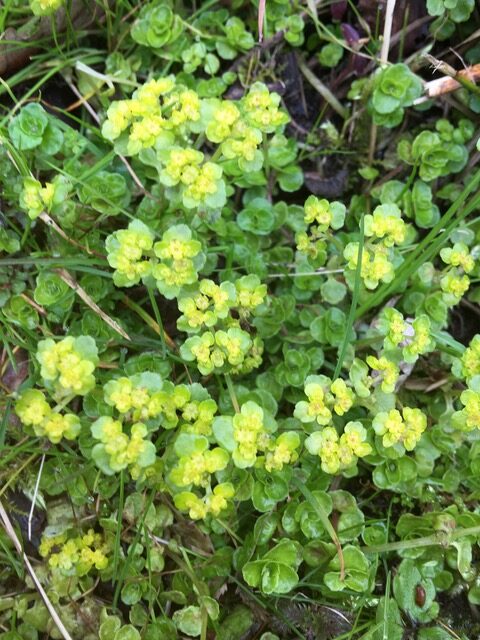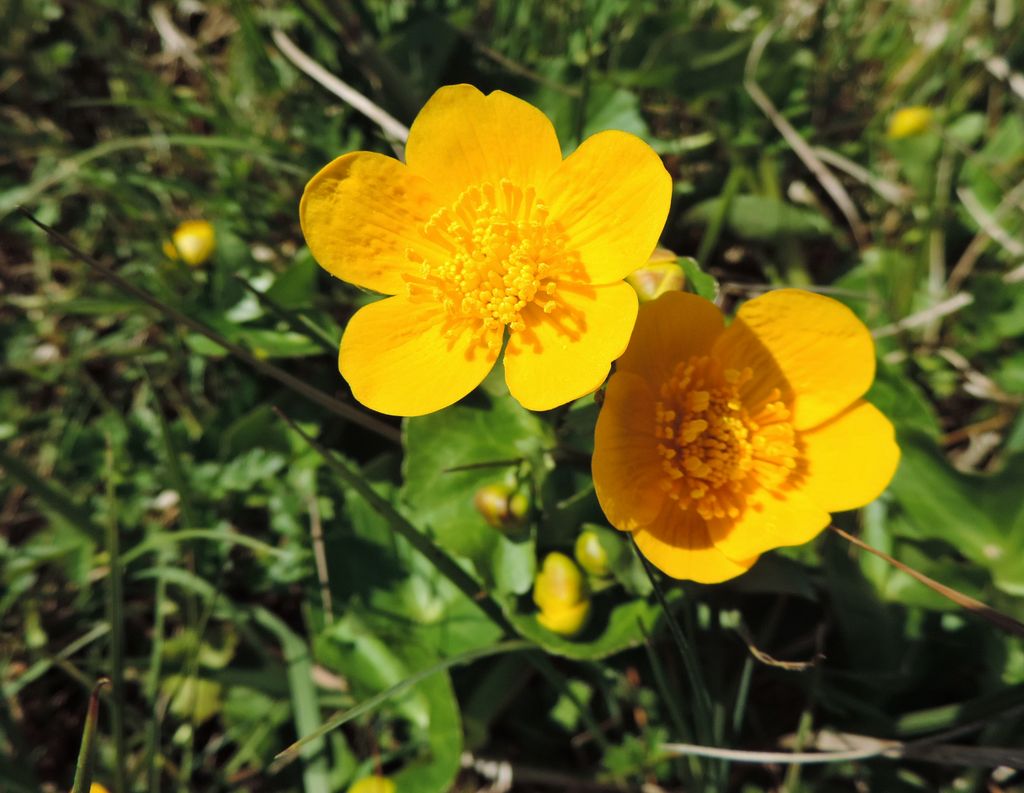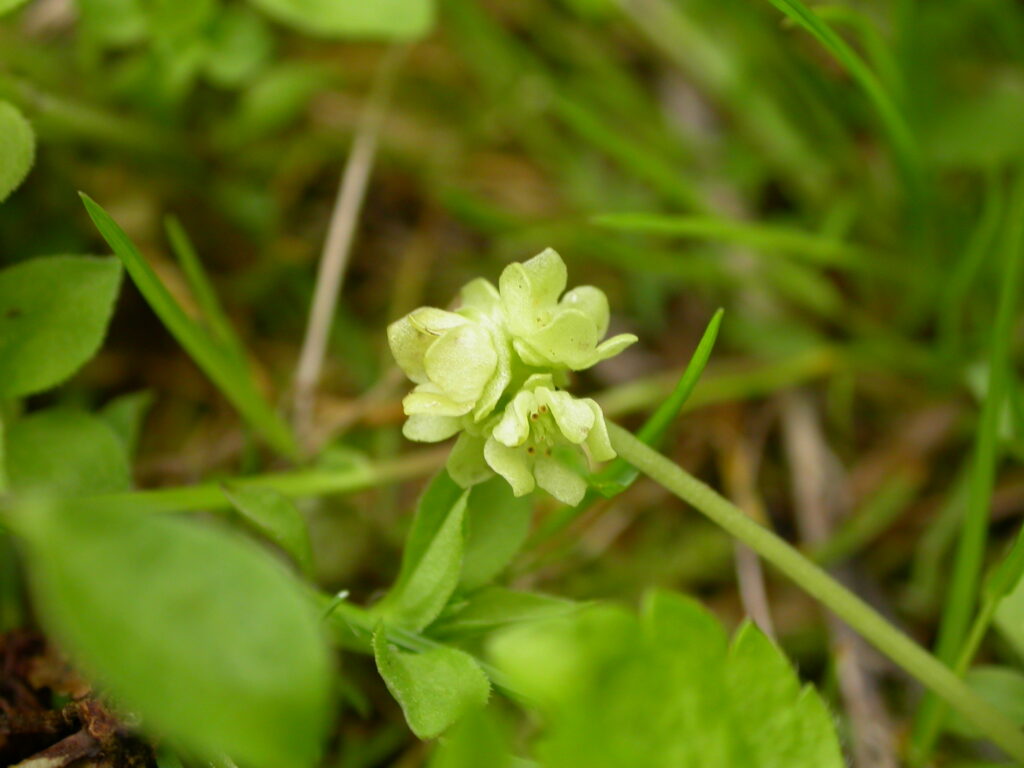Roger Dobbs led a walk round BBOWT’s Bowdown Woods reserve on the cold grey morning of Saturday 27 April. The reserve lies to the north of Greenham Common, where the land slopes steeply down to the valley of the River Kennet. The visit had been timed to catch Bluebell time at its peak and parts of the reserve were a sea of blue. Roger described the great variety of the woodland within the reserve, caused by variations in geology, aspect, hydrology and management history. The morning’s aim was to explore the western part of the Bowdown Woods complex. The walk started out along the main track around the bomb site, but soon turned left along a path which followed the edge of the Bowdown House grounds. First stop was an area of woodland with scattered big oak trees with Bluebells beneath them. Roger estimated that the oaks were several hundred years old. Bird and bat boxes had been attached to trees throughout the reserve, including the ones which were being inspected here. The garden of Bowdown House had a thicket of Bamboo up against the boundary fence. Roger said that they did their best to remove any Bamboo which spread into the reserve. The path crossed two steep-sided valleys. On the right of the path, in an area of woodland, a moss-covered oak had a fern growing high up on one of its branches. Flowers of Solomon’s-seal and Greater Stitchwort were seen. Piles of branches marked where Holly had been cut down. It had been increasing rapidly, shading out the ground flora. Roger pointed out an open area on the left of the path which he said was good for Grass Snakes and Slow-worms. Formerly there had also been Adders here. Gravel had been extracted from here, then later the excavated area had been filled with paper and pulp from the board mills at Colthrop. There will soon be a good display of Foxgloves. The path continued to the site of an earlier location of the reserve car park. The approach track had been closed to deter nuisance users. A Muntjac deer crossed the field on the other side of the track.
The next path turned back into the reserve, heading east and north through another fine display of Bluebells. A party of Long-tailed Tits was seen and Blackcap, Chiffchaff and Blackbird were heard. A path which led steeply down to the northern boundary of the reserve had been closed, due to the danger of falling Ash trees infected by Ash Dieback disease. Roger said that BBOWT is spending £3/4 million on removing diseased Ash trees from the reserve. He pointed out the site of the first coppice plot which volunteers had worked on here. The Hazels were looking rather dense and in need of a cut. Continuing along the path, Roger pointed out the most recent coppice plot. It had not been left as clear and open to the sun as he would have liked, because diseased Ash trees had not been felled. Habitat piles of brash and wood had been left as cover for wildlife. Continuing along the path, flowers of Wood-sorrel were seen, then a board-walk crossed a boggy section. A few flowers of Opposite-leaved Golden-saxifrage were spotted down in the mire and Bog Stitchwort was found. The next section of wet woodland was described by Roger as Alder carr. The Alders had tall straight stems, with the wood good for gunpowder and charcoal. Also, it does not rot in wet conditions. The path climbed into a drier section where Yellow Archangel, Wood Spurge, Moschatel and Three-nerved Sandwort were all found in flower. On the right hand side of the path, a number of dead or dying Ash trees had patches of the white lichen Phlyctis argena on their trunks. A diseased Ash with a deep crack had been cut off higher up, in case the crack was home to a bat or bird. Flowers of Wood Anemone, Bugle and Cuckooflower were found in this section and a Green Woodpecker was heard. The path led to the bottom of a wide valley which is kept open and runs up to the boundary with Bowdown House. Turning up the valley, a pond on the left is a good place to see dragonflies in summer. The management policy is to keep at least a third of the surface clear, and encroaching reeds and sedges are removed. Marsh-marigolds made a bold splash of yellow around the pond and higher up the valley. Bramble and raspberry scrub is cut back, creating a good habitat for blue butterflies. Heather was growing in places on the side of the valley and the leaves of Pignut and Common Sorrel were found here. After climbing up to the top of the valley, the route led back to the Bomb-site main track. A few members returned to the car park at this point, but the rest spent a little while exploring the Bomb-site. Willow Warbler and Blackcap were singing. The management plan aims to keep a field at the top of the site open. Scrub and trees increased undesirably during Covid but the BBOWT management team now have access to a small tractor with cutting implements and are bringing the scrub under control. The underside of several reptile refuges were inspected. One sheltered two Slow-worms and another sheltered a single Slow-worm.





Pictures by Rob Stallard
